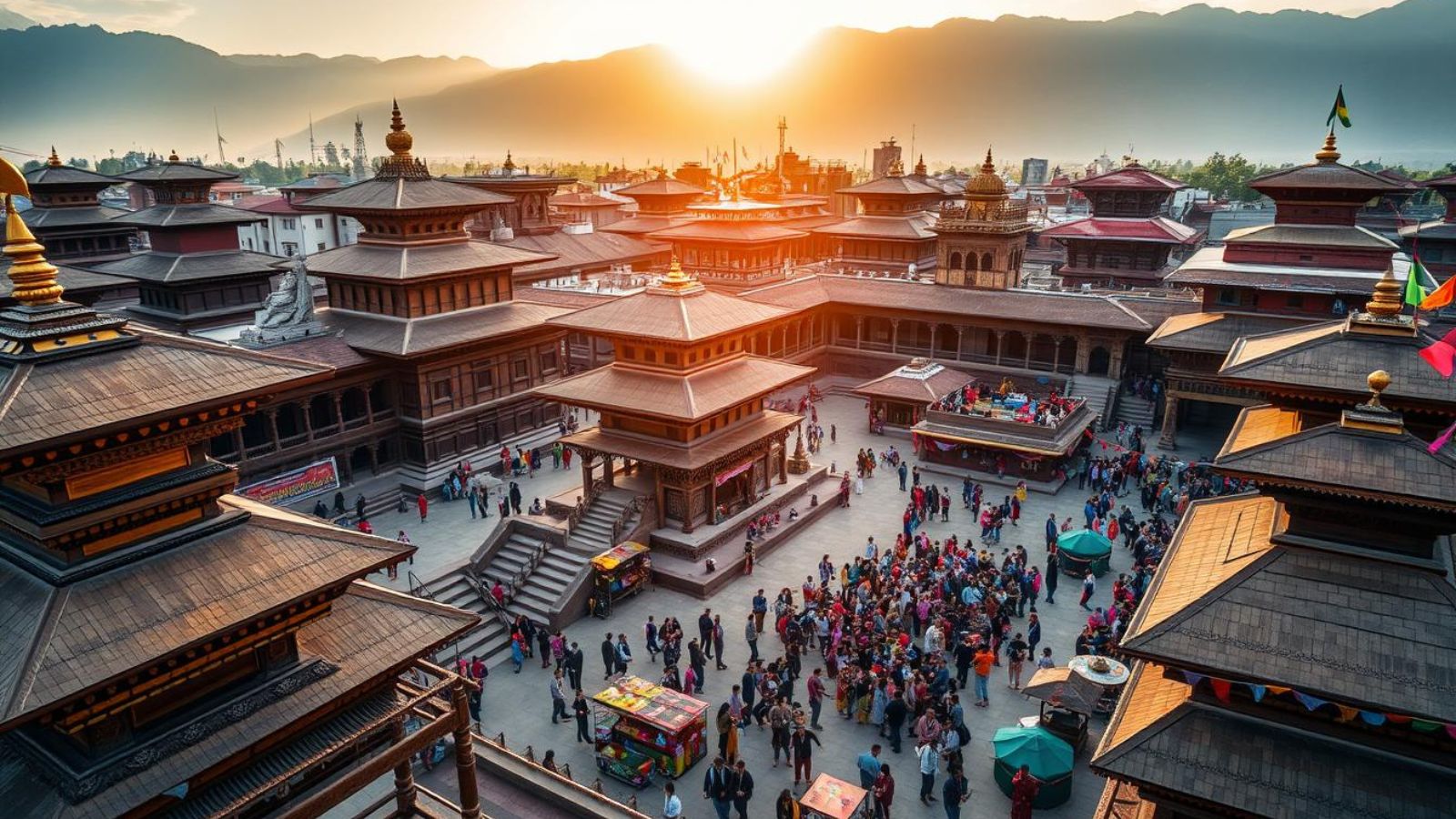Kathmandu Durbar Square: A Historic Jewel of Nepal

Strong 8k brings an ultra-HD IPTV experience to your living room and your pocket.
Kathmandu Durbar Square, often referred to as the heart of Kathmandu, is one of the most iconic landmarks of Nepal. Located in the heart of the capital city, the sprawling complex is a testament to Nepal's rich cultural, architectural, and historical legacy. Since 1979, Kathmandu Durbar Square has been listed as one of the UNESCO World Heritage Sites and is epitomized as the artistic and royal splendor that characterized Nepalese architecture for centuries. This article goes through the history, architecture, and importance of Kathmandu Durbar Square to look at the closer look of its very interesting past and present.
History of Kathmandu Durbar Square
Kathmandu Durbar Square, also known as Hanuman Dhoka Durbar Square, has been the royal palace complex for centuries. Its history dates back to the 12th century. The history of the square is closely associated with the dynasties that ruled the Kathmandu Valley, each of which left its mark on the architecture and grandeur of the palace. The square became the center of political and royal activities, hosting important events, festivals, and rituals.
The name "Hanuman Dhoka" is derived from the Hindu deity Hanuman, whose statue stands at the entrance of the Durbar Square. The square was originally known as a hub of royal life, where the kings of the Malla Dynasty reigned for centuries, followed by the Shah Dynasty. Kathmandu Durbar Square, over time, evolved into a symbol of the nation's history and royal authority.
The Malla Dynasty (12th–18th Century)
The history of the square dates back to the 12th century when King Laxmi Narayan Malla initiated the structure of parts of the royal palace. However, most architectural contributions to the square was in the period of the Mallas during the 14th to the 18th century. Several temples, palaces, and courts were built by the kings of the Malla dynasty in this period.
During the Malla Dynasty, Kathmandu flourished as an artistic, cultural, and religious center. Iconic architectural expressions of the square-the woodwork, stone carvings- reflect the sophistication of this period. Key architectural elements like pagoda-style temples, majestic courtyards, intricately carved windows, and doors were all fruits of the rule of Malla kings. The Malla dynasty also established the Hindu dominance in Nepal. This is evident with the numerous temples of the square that are Hindu-based.
The Shah Dynasty (18th Century-Present)
In late 18th century, Nepal was unified by Prithvi Narayan Shah, the founder of the Shah Dynasty. The royal seat of power remained here in Kathmandu Durbar Square until the monarchies were officially abolished in 2008. Under the reign of the Shah kings, it was extended by the addition of several other buildings in the square, including important structures such as Kasthamandap, a wooden structure for meeting among local people, and Gaddi Baithak, the throne room of the royal. Despite the end of the monarchy, Kathmandu Durbar Square is a heritage site representing the royal history of Nepal.
Architectural Kathmandu Durbar Square
Kathmandu Durbar Square is a great blend of Nepalese traditional architecture, especially the Newar architectural style. The square is bursting with royal palaces, temples, shrines, and courtyards. For even more magnificence, the beauty of the architecture is reflected in the detailed wood carvings, the graciously carved stone statues, and the majestic pagoda-style roofs. It's been divided into several sections, each having its peculiar features with specific purposes.
Some of the most notable structures in Kathmandu Durbar Square include:
The Hanuman Dhoka Palace: The palace complex is one of the main attractions in the square. It was the royal residence of the Malla kings and later the Shah kings. The palace is composed of multiple buildings, courtyards, and shrines, offering visitors a glimpse of the opulence that once defined the royal lifestyle.
Kasthamandap : This ancient wooden pavilion is an architectural marvel. The term "Kasthamandap" is derived from the Sanskrit words "Kastha," meaning wood and "Mandap," pavilion, for the entire edifice is cut from a tree. It was constructed in the 12th century AD and was known as a great gathering place by the local residents.
The Taleju Temple It is one of the most prominent religious sites within Kathmandu, dedicated to Taleju, a Hindu goddess, and has the beautiful pagoda-style roof located on a platform in the square.
The Kal Bhairab Temple: This temple houses the fearsome Hindu deity Kal Bhairab. The temple's peculiarity is the massive stone statue of Kal Bhairab, which is used in several religious ceremonies.
The Kumari Ghar (Kumari Temple): The Kumari Ghar is the residence of the living goddess, Kumari, a prepubescent girl worshipped as a god in Kathmandu. This temple is a stunning architectural piece, and it forms one of the most visited places in the Durbar Square.
Kathmandu Durbar Square Images
For visitors and photography enthusiasts, Kathmandu Durbar Square offers endless opportunities to capture the beauty of ancient Nepalese architecture. The intricate carvings on the palace walls, the statues of gods and kings, and the vibrant atmosphere make for stunning photos. The fusion of old buildings, colorful temples, and traditional daily life provide an authentic portrayal of Kathmandu's cultural richness.
Many photographs of the square were taken, showcasing the busy crowds of locals and tourists, the vendors selling the traditional items, and the life of the square that continues up to this day. Early morning shots can capture the serene beauty of the temples and courtyards while evening photos highlight the transformation of the square into a hub of activity.
Kathmandu Durbar Square Timings
Kathmandu Durbar Square is open all days of the week, though the visiting hours vary with seasons. The general visiting hours for the square are between 9:00 AM and 5:00 PM. Some temples and buildings may have specific times when the worshippers can visit, or on certain religious occasions. The square becomes very crowded at times, especially during festivals such as Dashain and Tihar, where various cultural performances and rituals take place.
The Significance of Kathmandu Durbar Square
Kathmandu Durbar Square is very significant to Nepal in terms of its cultural and historical values. It is not only a marvelous architectural creation but also a living testimony to the country's diversified history. Being the former seat of Nepal's monarchy, the square represents the power and grandeur of the kings who once ruled the Kathmandu Valley.
For Nepalese people, Kathmandu Durbar Square represents national pride and cultural heritage. It is the focal point for many religious celebrations and festivals, especially those that involve the royal family or state affairs. It also serves as a meeting point for people from all walks of life.
There has been a challenge with the square, especially in recent years, mostly after the catastrophic earthquake of 2015. The earthquake did much damage to several buildings and structures. Yet restoration works have been under way, and the square is slowly being regained to its original state.
Conclusion
This place is one of the main must-visit sites for people who are interested in Nepalese history, culture, and architecture. It encompasses palaces, intricate temples, and showcases the richness of the nation's heritage at its capital's core. If it's the historical value of the structure, some really stunning photographs, or just to absorb the pulsating atmosphere, Kathmandu Durbar Square leaves an experience to be cherished about the ever-resilient spirit of Nepal.
Note: IndiBlogHub features both user-submitted and editorial content. We do not verify third-party contributions. Read our Disclaimer and Privacy Policyfor details.


